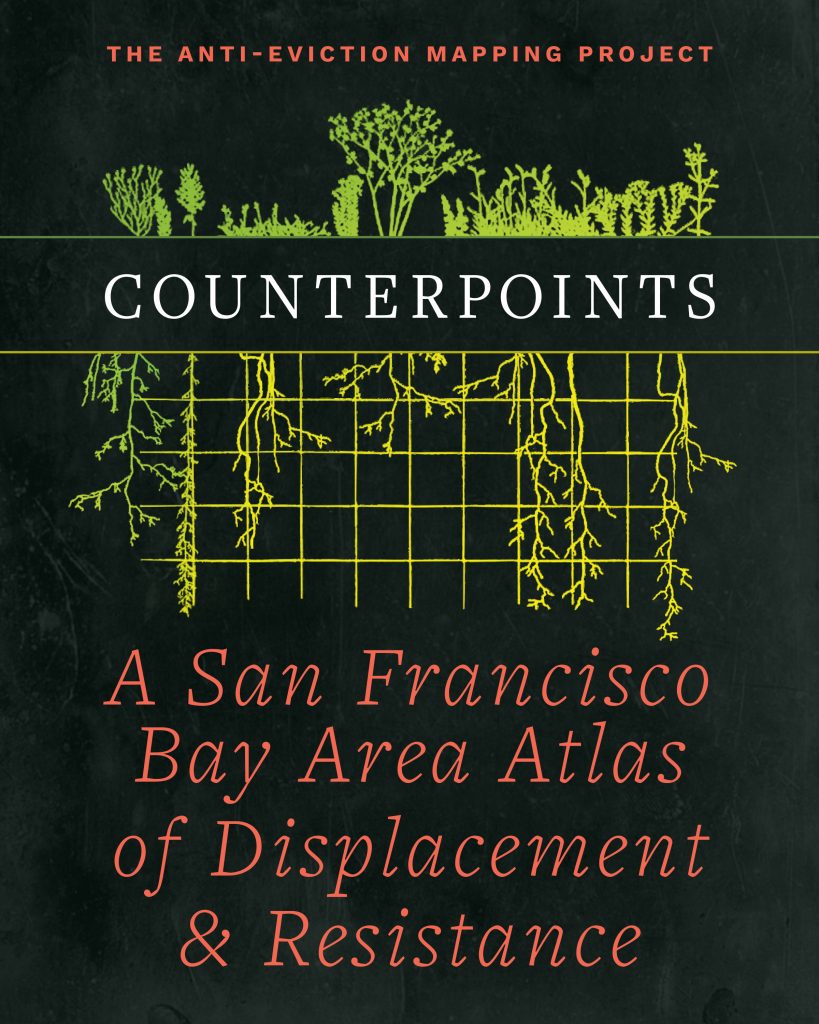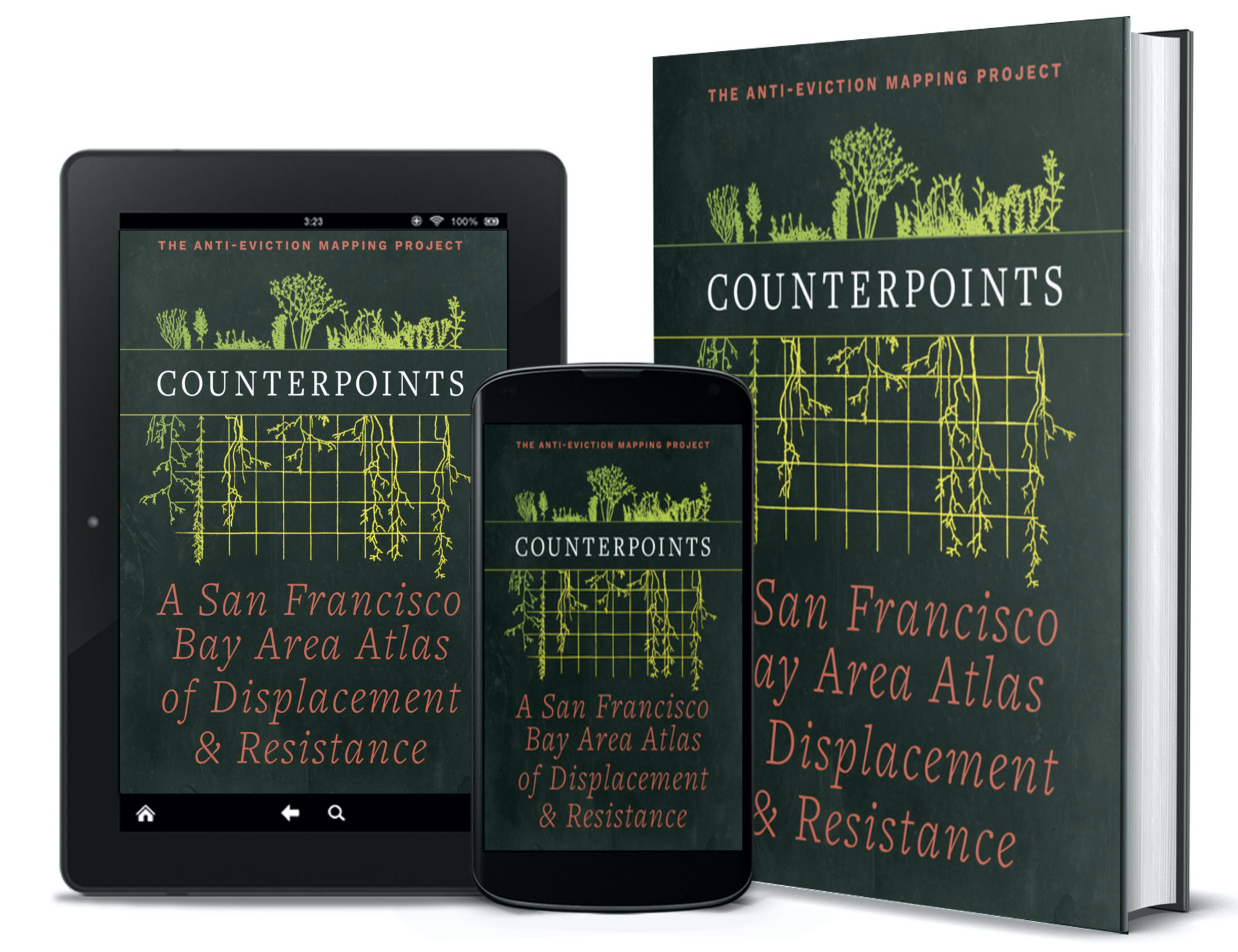By Alexander Tarr
International Journal of Urban and Regional Research
The Anti-Eviction Mapping Project (ed.) 2021: Counterpoints: A San Francisco Bay Area Atlas of Displacement and Resistance. Oakland, CA: PM Press
As their phenomenal book recounts, the Anti-Eviction Mapping Project (AEMP) formed in the fall of 2013, when a group of activists gathered at the San Francisco Tenant Union agreed to map the rapidly escalating evictions in the city. Their first animated web map, where the city appears to be blown apart by evictions, quickly became an example par excellence of urban counter-mapping. In the ensuing years, the growing collective has gone on to collaborate with dozens of organizations, launched chapters in other American cities, and produced a wide variety of media and events against displacement. Throughout their work, they have maintained a radical approach to grassroots activism and scholarship, especially in their commitment to ethical data practices and creative methods and outputs. The edited volume Counterpoints: A San Francisco Bay Area Atlas of Displacement and Resistance brings together a selection of materials demonstrating the history and significance of this work.
In both Erin McElroy’s introduction and Magie Ramírez’s epilog to the book, they describe it as an ‘archive’. Indeed, Counterpoints goes far beyond what the ‘atlas’ label suggests. It contains nearly 400 pages of short essays, interviews, art pieces, photographs, poetry, reflections on organizing, highly theorized studies and deeply personal polemics. Dozens of different individuals and organizations contributed materials. Consequently, each turn of the page adds to the sense that, in the San Francisco Bay Area at the start of the twenty-first century, economic and cultural transformations up-ended dominant narratives about the terrain on which struggles over rights to urban space are fought.
Over 100 different pieces go into making this archive about how different communities responded to new and surprising waves of violent displacements. On its surface, the volume documents how the AEMP and their interlocutors built on decades of activism to challenge the right of capitalists to maximize profit in real estate. At a deeper level, however, it also shows how these activists are simultaneously challenging and re-making the nominally progressive Bay Area politics that failed to stop the on-going destruction of communities. From mapping ‘unlawful detainers’ in Oakland (pp. 23–6) to poems like ‘I Dream of a World’ (p. 345), the collective argues that it is both insufficient and impossible to halt processes like gentrification without understanding that they are fundamentally the products of racial-capitalism, settler-colonialism and carceral logics.
The atlas primarily covers the period between 2013 and 2016, but it also draws on older data and engages with deep histories of displacement and resistance stretching back to the initial Indigenous struggles against colonization. The editors have organized the varied materials into seven thematic sections: Evictions and Root Shock; Indigenous Geographies of Resistance; Health and Environmental Justice; Gentrification and State Violence; Transportation Infrastructure and Economy; Migrations/Relocations; Speculation and Speculative Futures; and an epilog titled ‘Imagining Bay Area Futures’. However, part of the brilliance and challenge of the book is that any one piece threads together many different dimensions of community struggles that speak to these themes across chapters.
To give one example, the section on ‘Gentrification and State Violence’ includes several excerpts from an AEMP project called Unsettled Mission. Here, Adriana Camerena summarizes her interview with a Spokane-Kalispel Native American woman identified as Gaby about her experience of being houseless and a sex worker in the Mission district of San Francisco (pp. 205–7). Their discussion ranges from the impossibility of acquiring stable housing without proof of income to fearing the police and the danger of being pushed to work in unfamiliar, far-flung neighborhoods. It builds on earlier pieces focused on the on-going racialized dispossession of Indigenous peoples and draws a connecting line through to maps of immigrant geographies. In this way, the book brings together many different voices, styles and kinds of data into a collage that preserves the uniqueness of individual experiences while showing the interconnectedness of the forces which shape displacement.
Trying to capture the full scale of the AEMP’s work within a single volume inevitably has its limits. The translation of many of their digital maps into static print versions has meant the loss of much of the nuanced data exploration, interpretation and affective power present in their web-based interactive counterparts. Consequently, many of the maps (with some notable exceptions) are minimally labeled and require the reader to bring their own well-developed sense of Bay Area and California geography to contextualize what is being shown. Nor can a print volume capture the full range of multimedia storytelling the collective has developed as an essential part of its work (though fortunately, this work is still accessible at antievictionmap.com). Not least, Counterpoints engages with a kind of archiving and mode of focused argumentation that is still difficult to achieve in the ephemeral and infinitely hyperlinked internet.
Readers will not find narrowly defined academic housing debates in this volume, nor ready-made policy solutions, or even technical guides to mechanisms like ‘rent control’. The book’s sights are focused on a far more complex and often messy accounting of how the lived experiences of communities collide with the social and economic power structures that stand in the way of both stability and liberation. The AEMP offers compelling methodologies for how to do this work, from collecting personal stories and attempting to map where people go when displaced, to cataloging serial evictors and tracing speculative investments.
For all its inspiration, the book is also devastatingly honest about the insurmountable challenges to anti-displacement work. This dichotomy is captured in Eviction Free San Francisco’s reflection piece on how they organized five buildings into permanent affordable housing, conceding that in the end, ‘a combination of burnout, the many types of unchecked white privilege in activist circles, lack of access to meetings for folks from all of the neighborhoods, the grief of community displacement, living at ground zero of the global tech dystopia, different types of evictions happening faster, and many activists moving to ballot initiative work led us to disband’ (p. 57).
Ultimately, the real work of these types of stories, alongside many data-driven visualizations, is to insist that the Bay Area’s future is not ‘terra nullius’ (p. 330), open to endless accumulation. Rather, as Erin McElroy and Manissa Maharawal write, the book’s contributions ‘show that it is possible to resist capitalist speculation and dream of futures that defy its logics’ (p. 330).
Alexander Tarr is a human geographer and Assistant professor of Geography at Worcester State University.
The Anti-Eviction Mapping Project (ed.) Counterpoints: A San Francisco Bay Area Atlas of Displacement and Resistance. Oakland, CA: PM Press © 2021. Cover used with permission of PM Press.
Views expressed in this section are independent and do not represent the opinion of the editors.







